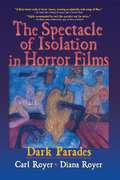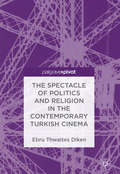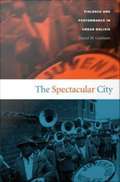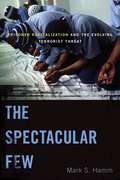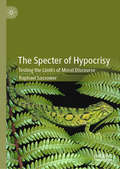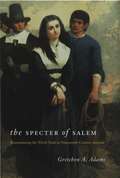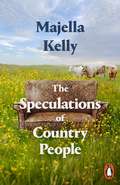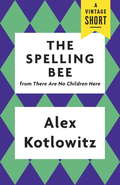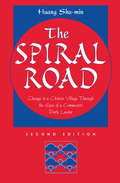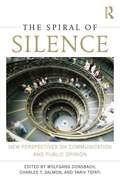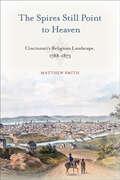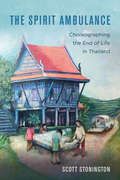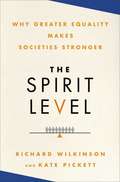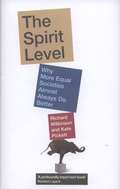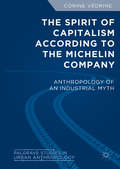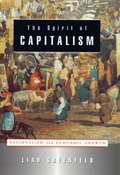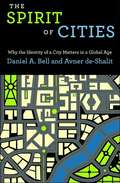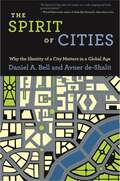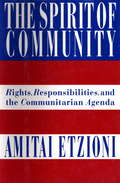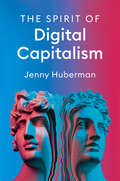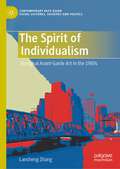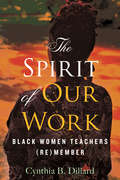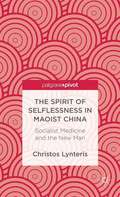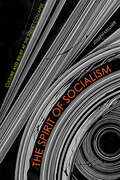- Table View
- List View
The Spectacle of Isolation in Horror Films: Dark Parades
by Carl Royer B Lee CooperGo behind the scenes with an insightful look at horror films-and the directors who create them The Spectacle of Isolation in Horror Films: Dark Parades examines the work of several of the genre&’s most influential directors and investigates how traditional themes of isolation, alienation, death, and transformation have helped build the foundation of horror cinema. Authors Carl and Diana Royer examine the techniques used by Alfred Hitchcock that place his work squarely in the horror (rather than suspense) genre, discuss avant-garde cinema&’s contributions to mainstream horror, explore films that use the apartment setting as the "cell of horror," and analyze how angels and aliens function as the supernatural "Other." A unique resource for film students and film buffs alike, the book also examines Sam Raimi&’s Evil Dead trilogy and the fusion of science, technology, and quasi-religious themes in David Cronenberg&’s films. Instead of presenting a general overview of the horror genre or an analysis of a specific sub-genre, actor, or director, The Spectacle of Isolation in Horror Films offers an imaginative look at classic and contemporary horror cinema. The book examines Surrealist films such as Un Chien Andalou and Freaks, the connections among the concepts of voyeurism, paranoia, and alienation in films like Rear Window, Rosemary&’s Baby, Blue Velvet, and The Blair Witch Project; the use of otherworldly creatures in films such as The Prophecy, Dogma, and The Day The Earth Stood Still; and the films of directors George Romero, John Waters, and Darren Aronofsky, to name just a few. This unique book also includes an extensive A-to-Z filmography and a bibliography of writings on, and about, horror cinema from filmmakers, film critics, and film historians. The Spectacle of Isolation in Horror Films examines: "Body Doubles and Severed Hands"-the common ancestry of avant-garde "art" films and exploitation horror B-movies "And I Brought You Nightmares"-recurring themes of psychological terror in Alfred Hitchcock&’s films "Horror, Humor, Poetry"-Sam Raimi&’s transformation of "drive-in" horror cinema "Atheism and 'The Death of Affect'"-David Cronenberg&’s obsessions, interests, and cautionary messages in films ranging from Videodrome to Dead Ringers to eXistenZ and much more!The Spectacle of Isolation in Horror Films: Dark Parades is a unique resource of critical analysis for academics working in film and popular culture, film historians, and anyone interested in horror cinema.
The Spectacle of Politics and Religion in the Contemporary Turkish Cinema
by Ebru Thwaites DikenThis book explores how politics, religion and cinema encounter and re-invent each other in contemporary Turkish cinema. It investigates their common origin—the spectacle, which each field views as an instrument of governmentality. The book analyses six recent, some of which are internationally known Turkish films: The Messenger (Ulak), A Man’s Fear of God (Takva), Let’s Sin (İtirazım Var), SixtyOne Days (İftarlık Gazoz), The Imam and The Shadowless (Gölgesizler). Thwaites discusses how the cinematic nature of politics and religion unfold amidst the increasing media visibility of religion in contemporary Turkey. The chapters explore the relationship between art and religion, and compare religion and philosophy in their relation to truth, belief, and economy. Through close examination of these films, the author highlights the role of cinema in contemporary Turkey and at the heart of the religious paradigm.
The Spectacular City: Violence and Performance in Urban Bolivia
by Daniel M. GoldsteinSince the Bolivian revolution in 1952, migrants have come to the city of Cochabamba, seeking opportunity and relief from rural poverty. They have settled in barrios on the city's outskirts only to find that the rights of citizens--basic rights of property and security, especially protection from crime--are not available to them. In this ethnography, Daniel M. Goldstein considers the significance of and similarities between two kinds of spectacles--street festivals and the vigilante lynching of criminals--as they are performed in the Cochabamba barrio of Villa Pagador. By examining folkloric festivals and vigilante violence within the same analytical framework, Goldstein shows how marginalized urban migrants, shut out of the city and neglected by the state, use performance to assert their national belonging and to express their grievances against the inadequacies of the state's official legal order. During the period of Goldstein's fieldwork in Villa Pagador in the mid-1990s, residents attempted to lynch several thieves and attacked the police who tried to intervene. Since that time, there have been hundreds of lynchings in the poor barrios surrounding Cochabamba. Goldstein presents the lynchings of thieves as a form of horrific performance, with elements of critique and political action that echo those of local festivals. He explores the consequences and implications of extralegal violence for human rights and the rule of law in the contemporary Andes. In rich detail, he provides an in-depth look at the development of Villa Pagador and of the larger metropolitan area of Cochabamba, illuminating a contemporary Andean city from both microethnographic and macrohistorical perspectives. Focusing on indigenous peoples' experiences of urban life and their attempts to manage their sociopolitical status within the broader context of neoliberal capitalism and political decentralization, The Spectacular City highlights the deep connections between performance, law, violence, and the state.
The Spectacular Few: Prisoner Radicalization and the Evolving Terrorist Threat (Alternative Criminology #13)
by Mark S. HammThe Madrid train bombers, shoe-bomber Richard Reid, al-Qaeda in Iraq, and the 9/11 attacks—all were led by men radicalized behind bars. By their very nature, prisons are intended to induce transformative experiences among inmates, but today’s prisons are hotbeds for personal transformation toward terrorist beliefs and actions due to the increasingly chaotic nature of prison life caused by mass incarceration. In The Spectacular Few, Mark Hamm demonstrates how prisoners use criminal cunning, collective resistance and nihilism to incite terrorism against Western targets. A former prison guard himself, Hamm knows the realities of day-to-day prison life and understands how prisoners socialize, especially the inner-workings and power of prison gangs—be they the Aryan Brotherhood or radical Islam. He shows that while Islam is mainly a positive influence in prison, certain forces within the prison Muslim movement are aligned with the efforts of al-Qaeda and its associates to inspire convicts in the United States and Europe to conduct terrorist attacks on their own. Drawing from a wide range of sources—including historical case studies of prisoner radicalization reaching from Gandhi and Hitler to Malcolm X, Bobby Sands and the detainees of Guantanamo; a database of cases linking prisoner radicalization with evolving terrorist threats ranging from police shootouts to suicide bombings; interviews with intelligence officers, prisoners affiliated with terrorist groups and those disciplined for conducting radicalizing campaigns in prison—The Spectacular Few imagines the texture of prisoners’ lives: their criminal thinking styles, the social networks that influenced them, and personal “turning points” that set them on the pathway to violent extremism. Hamm provides a broad understanding of how prisoners can be radicalized, arguing that in order to understand the contemporary landscape of terrorism, we must come to terms with how prisoners are treated behind bars.
The Specter of Hypocrisy: Testing the Limits of Moral Discourse
by Raphael SassowerRaphael Sassower examines the concept of hypocrisy for its strategic potential as a means of personal protection and social cohesion. Given the contemporary context of post-truth, the examination of degrees or kinds of hypocrisy moves from the Greek etymology of masks worn on the theater stage to the Hebrew etymology of the color adjustment of chameleons to their environment. Canonical presuppositions about the uniformity of the mind and the relation between intention and behavior that warrant the charge of hypocrisy are critically reconsidered in order to appreciate both inherent inconsistencies in personal conduct and the different contexts where the hypocrisy appears. Sassower considers the limits of analytic moral and political discourses that at times overlook the conditions under which putative hypocritical behavior is existentially required and where compromises yield positive results. When used among friends, the charge of hypocrisy is a useful tool with which to build trust and communities.
The Specter of Salem: Remembering the Witch Trials in Nineteenth-Century America
by Gretchen A. AdamsIn this book, the author reveals the many ways that the Salem witch trials loomed over the American collective memory from the Revolution to the Civil War and beyond. Schoolbooks in the 1790s, for example, evoked the episode to demonstrate the new nation's progress from a disorderly and brutal past to a rational present, while critics of new religious movements in the 1830s cast them as a return to Salem-era fanaticism, and during the Civil War, southerners evoked witch burning to criticize Union tactics. Shedding new light on the many, varied American invocations of Salem, the author ultimately illuminates the function of collective memories in the life of a nation. "Imaginative and thoughtful. Thought-provoking, informative, and convincingly presented, this book is an often spellbinding mix of politics, cultural history, and public historiography."-- New England Quarterly "This well-researched book, forgoing the usual heft of scholarly studies, is not another interpretation of the Salem trials, but an important major work within the scholarly literature on the witch-hunt, linking the hysteria of the period to the evolving history of the American nation. A required acquisition for academic libraries."--Choice, Outstanding Academic Title 2009
The Speculations of Country People
by Majella Kelly'Ruminative and enigmatic . . . powerful' Simon Armitage'Tenderly inquisitive . . . a powerful poetry of witness . . . full of discovery' Alycia Pirmohamed'Majella Kelly offers so much: ecstatic lyricism . . . emotional excavation and virtuosic skill' Kathryn Maris The astonishing poetry debut exploring hidden histories, mythical landscapes and self-discovery in the face of limits on women's bodily autonomyIn 2017, the presence of a mass grave was confirmed in a disused sewage system in Tuam, County Galway. In it were the bodies of infants - wards of the Bon Secours Mother and Baby Home, where from 1925 to 1961 the children of unmarried women were sent to live their lives in the care of nuns. Their deaths were the result of a conservative culture which, under the influence of the Church, took a prurient interest in women's private lives and bodies.In The Speculations of Country People, her hauntingly lyrical debut collection, Majella Kelly reckons with that legacy. She traces the journeys of women in our own day, from controlling relationships to sexual reawakening and new happiness. The speculations of the title are in part those of gossip, the chatter of small communities everywhere; but they are also those of a local, very Irish mythos, in which pagan and Christian - and truth and legend - blend and blur.Here, then, are hares and selkies, a seductive 'master otter' of 'fabulous elegance' who might carry a woman away in the night; here is the last man on Omey Island; here a retired stuntman, dragging his bed of rusty nails along the beach. And here - quiet, against the beauty and loneliness of the Connemara landscape - are the little bones that wash up on shores or stick from the earth to speak of what has been.
The Speculative City: Art, Real Estate, and the Making of Global Los Angeles
by Susanna Phillips NewburyA forensic examination of the mutual relationship between art and real estate in a transforming Los Angeles Underlying every great city is a rich and vibrant culture that shapes the texture of life within. In The Speculative City, Susanna Phillips Newbury teases out how art and Los Angeles shaped one another&’s evolution. She compellingly articulates how together they transformed the Southland, establishing the foundation for its contemporary art infrastructure, and explains how artists came to influence Los Angeles&’s burgeoning definition as the global city of the twenty-first century.Pairing particular works of art with specific innovations in real estate development, The Speculative City reveals the connections between real estate and contemporary art as they constructed Los Angeles&’s present-day cityscape. From banal parking lots to Frank Gehry&’s designs for artists&’ studios and museums, Newbury examines pivotal interventions by artists and architects, city officials and cultural philanthropists, concluding with an examination of how, in the wake of the 2008 global credit crisis, contemporary art emerged as a financial asset to fuel private wealth and urban gentrification. Both a history of the transformation of the Southland and a forensic examination of works of art, The Speculative City is a rich complement to the California chronicles by such writers as Rebecca Solnit and Mike Davis.
The Spelling Bee
by Alex KotlowitzAn eBook short.A selection from Alex Kotlowitz's masterpiece of immersive reportage There Are No Children Here, the harrowing coming-of-age story of two children in Chicago's Henry Horner Public Housing Complex. In "The Spelling Bee," as Pharoah returns to school, his dreams come up against the realities of his neighborhood. Pharoah is small of stature, has a stutter, and frequently reads at night until his eyes hurt. He has his mother's open and generous smile, and his father's charm and keen intellect. As he enters fourth grade, he sets a solemn goal for himself: to become a spelling bee champion. Award-winning journalist Alex Kotlowitz follows Pharoah for two years, as he tries desperately to succeed at school while navigating the perils of his devastated neighborhood, a place marked by deep need and neglect, along with unrelenting violence. For Pharoah, spelling is just the beginning. This is a dramatic and groundbreaking portrait of poverty, the story of growing up in the other America.
The Spiral Road
by Huang Shu-Min Shu-Min HuangThrough the eyes of the leading Party cadre in Lin Village in southeast China, this book unravels the turbulent events that affected individuals and families in the village: the downfall of the landlords during the Land Reform, the rise to political power of poor peasants, the political fanaticism of the Great Leap Forward and the Great Proletarian Cultural Revolution, and recent efforts to restore rational, pragmatic policies in ChinaOCOs countryside. The second edition includes two new chapters, based on the authorOCOs continuing visits to China. One chapter details changes in Lin Village, such as Taiwanese investment of capital, large-scale production, international marketing, and new lifestyles. The other focuses on the continuing story of Mr. Ye: his ideas for expanding the villagersOCO wealth, his wheeling and dealing to set up lucrative businesses in Lin Village, and his arrangements to secure jobs for his family members and close kin. "
The Spiral of Silence: New Perspectives on Communication and Public Opinion
by Wolfgang Donsbach Charles T. Salmon Yariv TsfatiSince its original articulation in the early 1970s, the 'spiral of silence' theory has become one of the most studied theories of communication and public opinion. It has been tested in varied sociopolitical contexts, with different issues and across communication systems around the world. Attracting the interest of scholars from communication, political science, sociology, public opinion and psychology, it has become both the subject of tempestuous academic debate as well as a mainstay in courses on communication theory globally. Reflecting substantial new thinking, this collection provides a comprehensive examination of the spiral of silence theory, offering a synthesis of prior research as well as a solid platform for future study. It addresses various ideological and methodological criticisms of the theory, links the theory with allied areas of scholarship, and provides analyses of empirical tests. Contributors join together to present a breadth of disciplinary and international perspectives. As a distinctive and innovative examination of this influential theory, this volume serves as a key resource for future research and scholarship in communicaiton, public opinion, and political science.
The Spires Still Point to Heaven: Cincinnati's Religious Landscape, 1788–1873 (Urban Life, Landscape and Policy)
by Matthew SmithA case study about the formation of American pluralism and religious liberty, The Spires Still Point to Heaven explores why—and more importantly how—the early growth of Cincinnati influenced the changing face of the United States. Matthew Smith deftly chronicles the urban history of this thriving metropolis in the mid-nineteenth century. As Protestants and Catholics competed, building rival domestic missionary enterprises, increased religious reform and expression shaped the city. In addition, the different ethnic and religious beliefs informed debates on race, slavery, and immigration, as well as disease, temperance reform, and education. Specifically, Smith explores the Ohio Valley’s religious landscape from 1788 through the nineteenth century, examining its appeal to evangelical preachers, abolitionists, social critics, and rabbis. He traces how Cincinnati became a battleground for newly energized social reforms following a cholera epidemic, and how grassroots political organizing was often tied to religious issues. He also illustrates the anti-immigrant sentiments and anti-Catholic nativism pervasive in this era. The first monograph on Cincinnati’s religious landscape before the Civil War, The Spires Still Point to Heaven highlights Cincinnati’s unique circumstances and how they are key to understanding the cultural and religious development of the nation.
The Spirit Ambulance: Choreographing the End of Life in Thailand (California Series in Public Anthropology #49)
by Scott StoningtonThe Spirit Ambulance is a journey into decision-making at the end of life in Thailand, where families attempt to craft good deaths for their elders in the face of clashing ethical frameworks, from a rapidly developing universal medical system, to national and global human-rights politics, to contemporary movements in Buddhist metaphysics. Scott Stonington’s gripping ethnography documents how Thai families attempt to pay back a "debt of life" to their elders through intensive medical care, followed by a medically assisted rush from the hospital to home to ensure a spiritually advantageous last breath. The result is a powerful exploration of the nature of death and the complexities arising from the globalization of biomedical expertise and ethics around the world.
The Spirit Level: Why Greater Equality Makes Societies Stronger
by Robert B. Reich Kate Pickett Richard WilkinsonThis eye-opening UK bestseller shows how one single factor--the gap between its richest and poorest members--can determine the health and well-being of a society. "This is a book with a big idea, big enough to change political thinking."--Sunday Times.
The Spirit Level: Why More Equal Societies Almost Always Do Better
by Kate Pickett Richard WilkinsonEveryone knows that the poor in rich societies are more likely to have shorter, less healthy, lives, to do less well at school and to end up on the wrong side of the law. But The Spirit Level goes further than this, to demonstrate for the first time that a whole range of social problems - from poor health to educational failure, from mental illness to obesity, from drug addition to violence, from teenage births to the weakening of community life - share one overwhelming feature: they are all several times more common in more unequal societies. The evidence that bigger income differences create more problems is conclusive. And rather than affecting just the poor, inequality reduces the quality of life for everyone in less equal. This groundbreaking work book, based on 30 years research by two of the UK's leading social epidemiologists, provides a powerful and fascinating new perspective on the social failings of rich societies. In light of their findings government policy will need serious rethinking.
The Spirit of Capitalism According to the Michelin Company: Anthropology of an Industrial Myth (Palgrave Studies in Urban Anthropology)
by Corine VédrineThe city of Clermont-Ferrand in central France is inextricably linked to the global tire company Michelin—not only by the industrial, social, and economic realities that tie employees to employer, but also by a multi-generational, regional belief in the company’s entrepreneurial mythos, the so-called “Michelin spirit.” Since the 1980s, transformations in capitalist systems have challenged the Michelin ideology: the end of corporate paternalism, the reduction of the work force, and a new wave of managers have left employees in the region feeling the sting of abandonment. Even in the face of these significant changes, however, the ethnographic enquiry at the heart of this book testifies to the enduring strength of the “spirit of capitalism”: even as the bonds between employees, companies, and their regions are undergoing significant transformation, entrepreneurial myths endure—in part in fear of the end of a secure, organizing structure.
The Spirit of Capitalism: Nationalism and Economic Growth
by Liah GreenfeldThe Spirit of Capitalism answers a fundamental question of economics, a question neither economists nor economic historians have been able to answer: what are the reasons (rather than just the conditions) for sustained economic growth? Taking her title from Max Weber's famous study on the same subject, Liah Greenfeld focuses on the problem of motivation behind the epochal change in behavior, which from the sixteenth century on has reoriented one economy after another from subsistence to profit, transforming the nature of economic activity. A detailed analysis of the development of economic consciousness in England, the Netherlands, France, Germany, Japan, and the United States allows her to argue that the motivation, or "spirit," behind the modern, growth-oriented economy was not the liberation of the "rational economic actor," but rather nationalism. Nationalism committed masses of people to an endless race for national prestige and thus brought into being the phenomenon of economic competitiveness. Nowhere has economic activity been further removed from the rational calculation of costs than in the United States, where the economy has come to be perceived as the end-all of political life and the determinant of all social progress. American "economic civilization" spurs the nation on to ever-greater economic achievement. But it turns Americans into workaholics, unsure of the purpose of their pursuits, and leads American statesmen to exaggerate the weight of economic concerns in foreign policy, often to the detriment of American political influence and the confusion of the rest of the world.
The Spirit of Cities: Why the Identity of a City Matters in a Global Age
by Daniel A. Bell Avner De-ShalitCities shape the lives and outlooks of billions of people, yet they have been overshadowed in contemporary political thought by nation-states, identity groups, and concepts like justice and freedom. The Spirit of Cities revives the classical idea that a city expresses its own distinctive ethos or values. In the ancient world, Athens was synonymous with democracy and Sparta represented military discipline. In this original and engaging book, Daniel Bell and Avner de-Shalit explore how this classical idea can be applied to today's cities, and they explain why philosophy and the social sciences need to rediscover the spirit of cities. Bell and de-Shalit look at nine modern cities and the prevailing ethos that distinguishes each one. The cities are Jerusalem (religion), Montreal (language), Singapore (nation building), Hong Kong (materialism), Beijing (political power), Oxford (learning), Berlin (tolerance and intolerance), Paris (romance), and New York (ambition). Bell and de-Shalit draw upon the richly varied histories of each city, as well as novels, poems, biographies, tourist guides, architectural landmarks, and the authors' own personal reflections and insights. They show how the ethos of each city is expressed in political, cultural, and economic life, and also how pride in a city's ethos can oppose the homogenizing tendencies of globalization and curb the excesses of nationalism. The Spirit of Cities is unreservedly impressionistic. Combining strolling and storytelling with cutting-edge theory, the book encourages debate and opens up new avenues of inquiry in philosophy and the social sciences. It is a must-read for lovers of cities everywhere.
The Spirit of Cities: Why the Identity of a City Matters in a Global Age
by Daniel A. Bell Avner de-ShalitA lively and personal book that returns the city to political thoughtCities shape the lives and outlooks of billions of people, yet they have been overshadowed in contemporary political thought by nation-states, identity groups, and concepts like justice and freedom. The Spirit of Cities revives the classical idea that a city expresses its own distinctive ethos or values. In the ancient world, Athens was synonymous with democracy and Sparta represented military discipline. In this original and engaging book, Daniel Bell and Avner de-Shalit explore how this classical idea can be applied to today's cities, and they explain why philosophy and the social sciences need to rediscover the spirit of cities.Bell and de-Shalit look at nine modern cities and the prevailing ethos that distinguishes each one. The cities are Jerusalem (religion), Montreal (language), Singapore (nation building), Hong Kong (materialism), Beijing (political power), Oxford (learning), Berlin (tolerance and intolerance), Paris (romance), and New York (ambition). Bell and de-Shalit draw upon the richly varied histories of each city, as well as novels, poems, biographies, tourist guides, architectural landmarks, and the authors' own personal reflections and insights. They show how the ethos of each city is expressed in political, cultural, and economic life, and also how pride in a city's ethos can oppose the homogenizing tendencies of globalization and curb the excesses of nationalism.The Spirit of Cities is unreservedly impressionistic. Combining strolling and storytelling with cutting-edge theory, the book encourages debate and opens up new avenues of inquiry in philosophy and the social sciences. It is a must-read for lovers of cities everywhere. In a new preface, Bell and de-Shalit further develop their idea of "civicism," the pride city dwellers feel for their city and its ethos over that of others.
The Spirit of Community
by Amitai EtzioniAmerica needs to move from me to we. In The Spirit of Community, renowned professor and former White House Fellow Amitai Etzioni, the founder of the Communitarian movement, lays out a blueprint for how in the 1990s Americans can move forward--together. The Spirit of Community calls for a reawakening of our allegiance to the shared values and institutions that sustain us--from our marriages and families to our schools and our neighborhoods, and extending to our nation itself. In proposing a new balance between our rights as individuals and our social responsibilities, this controversial, groundbreaking book articulates the emerging social attitudes of the nineties. We have many rights as individuals, Etzioni declares, but we have responsibilities to our communities, too. The right to be tried before a jury of our peers, for instance, is connected to our willingness to serve on one. We as a nation have in recent years forgotten such basic truths of our democratic social contract. And what we need now is a revival of the idea that small sacrifices by individuals can create large benefits for all of us. We must have the moral responsibility to respect our families and fight to preserve them, to value our children and their futures, and to be willing to espouse and teach commonly held moral values. Etzioni faces the tough issues that arise when the rights of individuals are weighed against those of the community, from free speech versus restrictions on hate speech to the right of police to conduct random checks of motorists' sobriety, from drug and HIV testing to mandatory national service. A movement that has already attracted the attention of policymakers as varied as Al Gore, Daniel Patrick Moynihan, Jack Kemp, and Henry Cisneros, Communitarianism provides a call to action and a perceptive analysis of American politics and society today. And The Spirit of Community is vital reading for any American who is engaged with the future of the country in the next decade.
The Spirit of Digital Capitalism
by Jenny HubermanDigital technologies are now central to the machinations of capitalism. How are they giving rise to new forms of capital accumulation and domination? And in what terms are these changes being promoted and justified by a new and incredibly powerful elite? This book takes on such questions. Beyond demonstrating how digital technologies make new forms of capital accumulation possible, Huberman interrogates the ideological transformations that have accompanied the emergence of digital capitalism. She examines how business gurus, entrepreneurs, and venture capitalists make claims about how digital technologies contribute to the common good, foster collaboration and connectivity, and render life more convenient, even if this convenience comes at the expense of values such as privacy and liberty. Ultimately, Huberman argues that the spirit of digital capitalism is Janus-faced and reveals deeper cultural contradictions at the heart of contemporary American society: promising, in the same moment, to liberate us and surveil us, enrich us, and yet render our lives more economically precarious. Smart and thought-provoking, this book offers new perspectives that will speak to anyone interested in the contours of contemporary capitalism, particularly students and scholars of economic anthropology and sociology.
The Spirit of Individualism: Shanghai Avant-Garde Art in the 1980s (Contemporary East Asian Visual Cultures, Societies and Politics)
by Lansheng ZhangThis book is about avant-garde art in Shanghai in the 1980s which challenges the narrative in the current discourse on the appearance of contemporary art in China. Offering fresh perspectives and new insights into the art and the artists of this period, the book includes critical events in Shanghai, that will attract the serious attention of art professionals and collectors. The emergence of the Shanghai art scene in the 1980s mirrors the revitalisation of Shanghai that was tasked to lead China’s economic development trajectory onto the world stage. Shanghai, with its semi-colonial, political, economic and cultural history, including the strong legacy of the early twentieth century modernist art movement, has played a vital role in China’s modernisation and presents itself as a unique case in the evolution of contemporary art in China.
The Spirit of Our Work: Black Women Teachers (Re)member
by Cynthia DillardAn exploration of how engaging identity and cultural heritage can transform teaching and learning for Black women educators in the name of justice and freedom in the classroomIn The Spirit of Our Work, Dr. Cynthia Dillard centers the spiritual lives of Black women educators and their students, arguing that spirituality has guided Black people throughout the diaspora. She demonstrates how Black women teachers and teacher educators can heal, resist and (re)member their identities in ways that are empowering for them and their students. Dillard emphasizes that any discussion of Black teachers&’ lives and work cannot be limited to truncated identities as enslaved persons in the Americas.The Spirit of Our Work addresses questions that remain largely invisible in what is known about teaching and teacher education. According to Dillard, this invisibility renders the powerful approaches to Black education that are imbodied and marshaled by Black women teachers unknown and largely unavailable to inform policy, practice, and theory in education. The Spirit of Our Work highlights how the intersectional identities of Black women teachers matter in teaching and learning and how educational settings might more carefully and conscientiously curate structures of support that pay explicit and necessary attention to spirituality as a crucial consideration.
The Spirit of Selflessness in Maoist China
by Christos LynterisAssuming power in 1949, the Chinese Communist Party was soon faced with a crucial problem: how to construct the socialist 'New Man'? Using Foucault's theory of 'technologies of the self', Lynteris examines the conflict between self-cultivation and the abolition of the self in the biopolitically neuralgic field of 'socialist medicine'.
The Spirit of Socialism: Culture and Belief at the Soviet Collapse
by Joseph KellnerThe Spirit of Socialism is a cultural history of the Soviet collapse. It examines the millions of Soviet people who, during the cascading crises of the collapse and the post-Soviet transition, embarked on a spirited and highly visible search for new meaning. Amid profound disorientation, these seekers found direction in their horoscopes, or behind gurus in saffron robes or apocalyptic preachers, or by turning from the most basic premises of official science and history to orient themselves anew. The beliefs they seized on and, even more, the questions that guided their search reveal the essence of late-Soviet culture and its legacy in post-Soviet Russia.To skeptical outsiders, the seekers appeared eccentric, deviant, and above all un-Soviet. Yet they came to their ideas by Soviet sources and Soviet premises. As Joseph Kellner demonstrates, their motley beliefs reflect modern values that formed the spiritual core of Soviet ideology, among them a high regard for science, an informed and generous internationalism, and a confidence in humanity to chart its own course. Soviet ideology failed, however, to unite these values in an overarching vision that could withstand historical change.And so, as The Spirit of Socialism shows, the seekers asked questions raised but not resolved by the Russian Revolution and subsequent Soviet order—questions of epistemic authority, of cultural identity, and of history's ultimate meaning. Although the Soviet collapse was not the end of history, it was a rupture of epochal significance, whose fissures extend into our own uncertain era.
